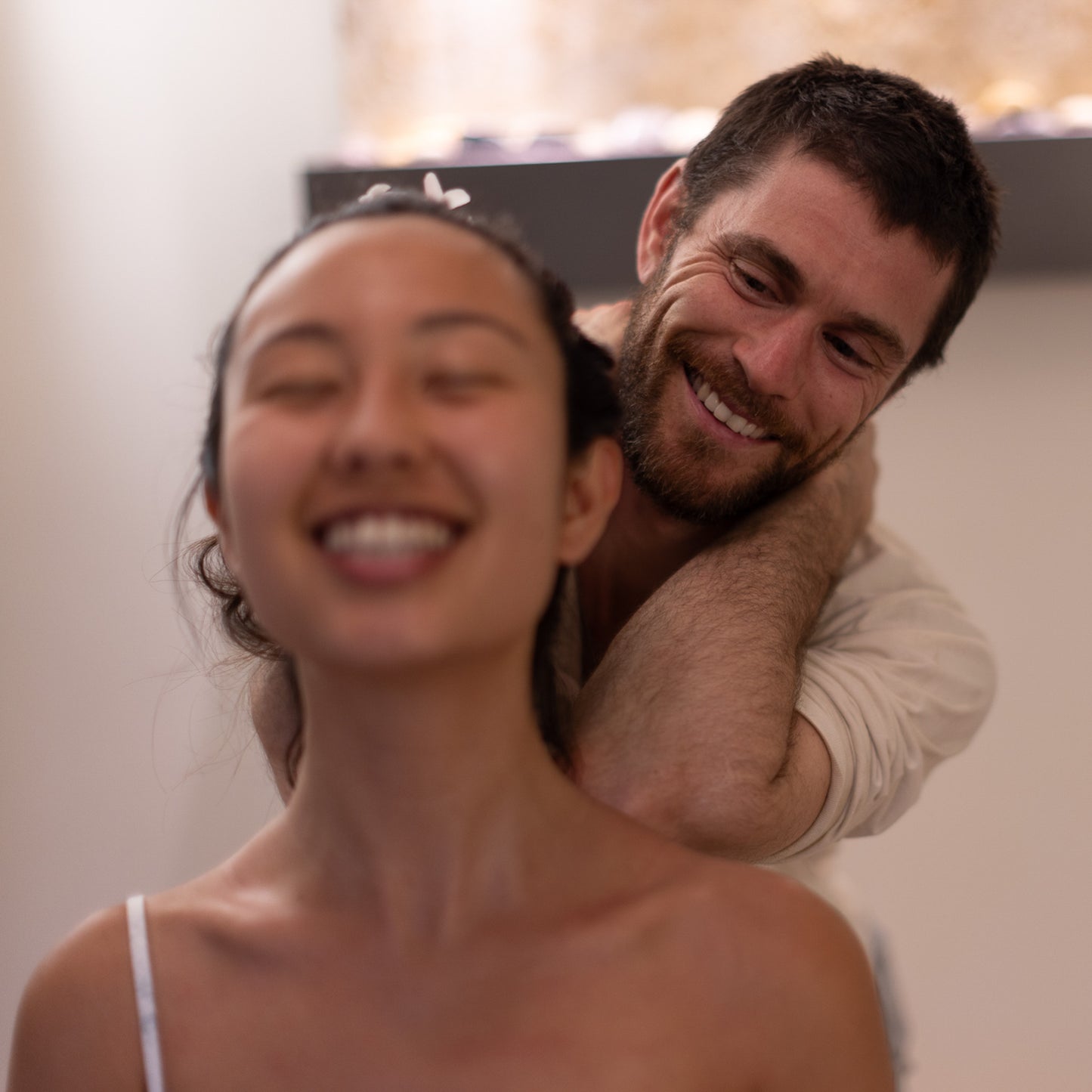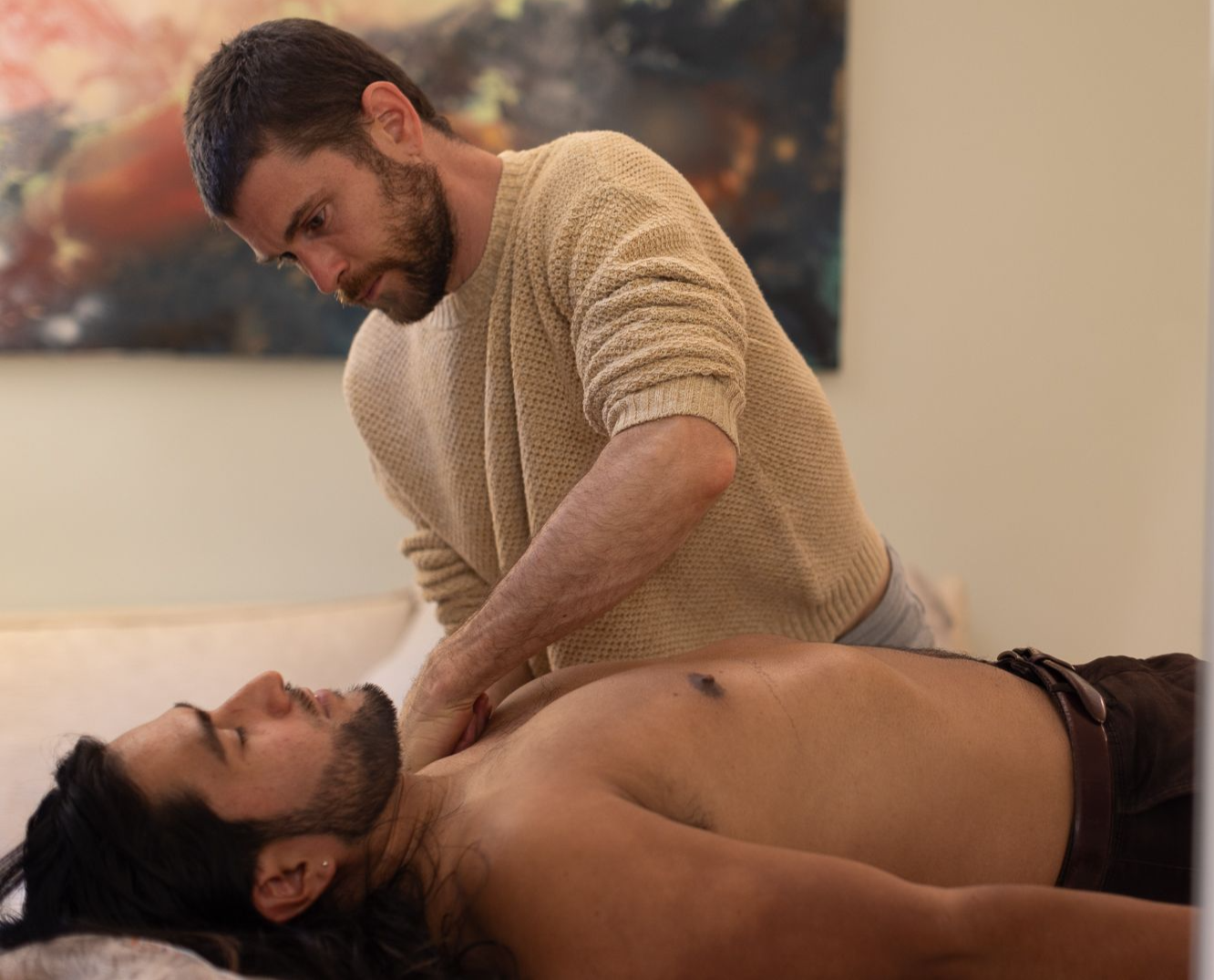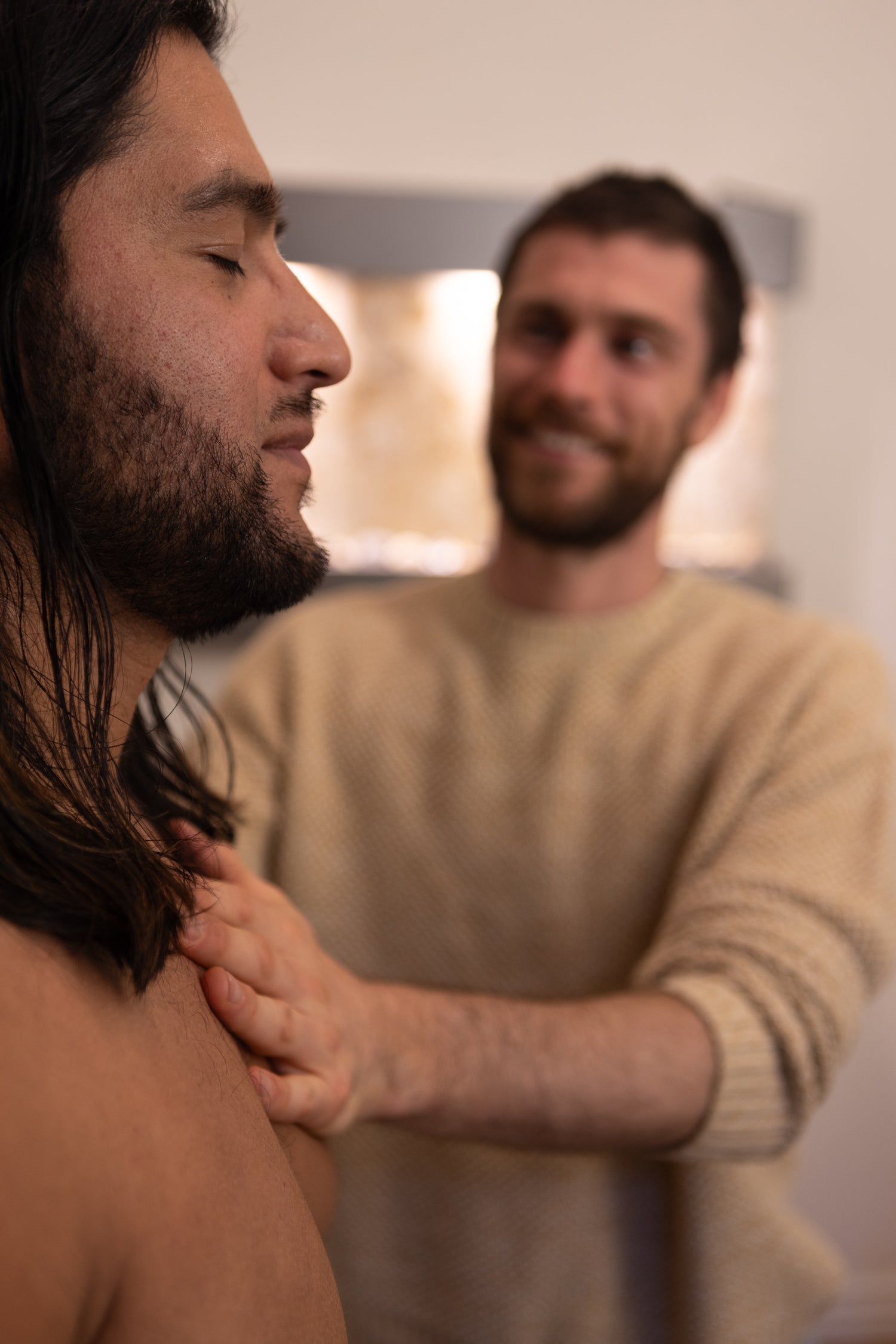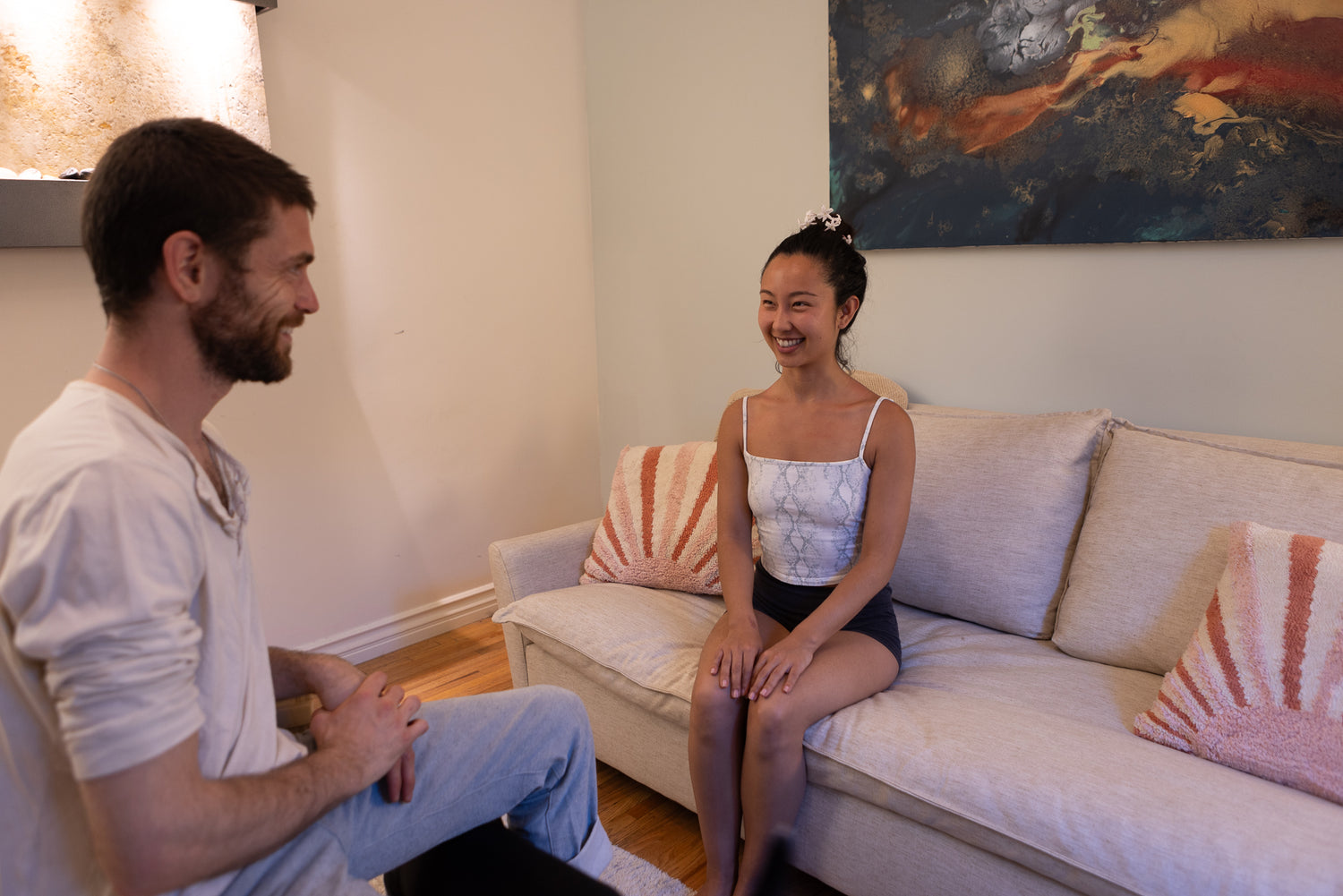My Store
Hellerwork
Hellerwork
Couldn't load pickup availability
Hellerwork is a somatic practice, crafted by Joseph Heller and derived from Ida Rolf’s System of Structural Integration Bodywork (Rolfing), which intentionally integrates the body, mind, emotions, energy and spirit. Whether caused by an injury, stress, or conditioned posture and positioning, the architecture of the body can shift over time to create a wide array of mental and physical discomforts and pains. Hellerwork aims to restore the whole body and Being into it’s naturally designed alignment by addressing these structural and functional patterns through physical touch, movement education, and self-awareness dialogue.
Share


Structural Bodywork
Fascia, or connective tissue, encapsulates every muscle fiber in the body and is what creates one’s posture; it is also where the body will experience injury and tightness. In Hellerwork, a practitioner starts by releasing the tension that exists in the most superficial layer of fascia, and systematically works into the deeper layers, eventually returning the body to an aligned position. Additionally, Hellerwork aims to restore one’s vertical alignment within the field of gravity and will optimize the physical structure to align within this field. This aspect of the work is a “hands on” process, in which Practitioners work with their hands to stretch, hydrate and unwind the fascia back into its optimal position. Releasing chronic tension and aligning the body within the field of gravity allows any body to feel easeful and rested, producing greater functioning in all aspects of one’s life.

Movement Integration
The way a person moves has a profound and lasting effect on their body. Some patterns that develop in the body are helpful, while others can keep it in a loop of poor posture or pain. Fascial patterns get fortified through consistency of movement in daily routine and if these movement patterns are largely unconscious, they may intensify over a lifetime and lead to further discomfort. Bringing conscious attention to how the body functions and responds when sitting, standing, walking, reaching, and engaging in familiar practices will retrain the conditioned patterns into new, more optimal ones. The Hellerwork Movement Integration work is educational in nature, and takes place both on and off the table during a session to help shift the effects of the bodywork to a much more sustainable and regenerative experience.

Self-Awareness Dialogue
Traditional massage and body work is often either a silent experience or one filled with casual chit-chat where the mind is invited to disassociate from the sensations of the body. However, when a person becomes aware and present of how their thoughts, feelings and beliefs relate to their physical experience, deeper connections are made and the states of the nervous system begin to shift. Once someone starts to feel and listen to the whispers of the body and nervous system, deeper healing occurs and begins to rewire the body-brain connection. Facilitated dialogue while receiving structural integration bodywork has the ability to engage the brain and bring about revelations and insights that might otherwise go undiscovered. Each session in the Hellerwork Series has an associated theme that partners with the physical territories in the body in order to create new neural pathways and connections between thoughts, emotions, sensations, memories and core beliefs.
A Typical Session
Regardless of whether a client comes in for a one-off session or is traversing through the Hellerwork Series, they can expect a similar format and structure. Each session will begin with a check-in around what is present and alive for the client in their body and relational world. Often, herbal tea will be offered as a way of settling the nervous system into the present moment. After that, a visual assessment will be taken of the body to bring awareness to any alignment issues and patterns that may be effecting posture and form. Then, the body-work will begin based on the areas of discussion (or placement in the Series) and generally last between 60-75 minutes. Once the table work is complete, a client will move over to the bench to wrap up with some seated neck and shoulder work, followed by another visual assessment to see what shifted in the session. The session ends with movement education where the client will have an opportunity to integrate the bodywork into walking, standing and sitting positions to incorporate into their daily lives.
The first three sessions work on the superficial layers of the connective tissues
Sessions 1-3
Session 1: Inspiration
The focus of the first session is on enhancing the quality of the breath, the building block of life. How a person breathes reveals a lot about how their body is functioning and vice-versa. Physical territories include the diaphragm, chest, shoulders, hips and ribcage.
Session 2: Standing on Your Own Two Feet
Session two moves from the building blocks of the breath to the foundational pillars of the feet and legs. This session looks at how a person operates independently, their relationship to standing on their own and holding their ground. Physical territories include the feet, ankles, calves, knees, quads, hamstrings, and hips.
Session 3: Reaching Out
Session three focuses on the functioning of the upper body and the ways we use our arms physically and metaphorically to reach out, whether in support or aggression. Physical territories include hips, lats, sternum, scapulae, shoulders, deltoids, and trapezius.
Sessions four through seven address patterns from deeper core layers of the body.
Sessions 4-7
Session 4: Control & Surrender
Session 4 enters into the ‘core sessions’ by exploring the origins of control and surrender which often take place in toddlerhood during toilet training. Healthy control involves sensitivity to feedback and a willingness to be flexible, creative and decisive. Heathy surrender involves letting go, placing trust in one’s environment and relationships. Physical territories include medial arch of foot, ankle retinaculum, adductor muscle group, ischial tuberosity (sits bones), and the ischial ramus (base of pelvis).
Session 5: The Guts
Session 5 explores the belly which is an often vulnerable and physically ignored source of emotion and memories. Often referred to as ‘the second brain’ the stomach is the home of intuition and ‘gut’ instinct. Physical territories include pectoralis muscles, shoulders, quads, abdominal muscles, umbilicus, obliques, iliacus, and psoas muscles.
Session 6: Holding Back
Session 6 flips the client over and explores the back body, often referred to as ‘the universal body.’ Without eyes to govern and scan the area, more sensory receptors develop in the back of the body, which often takes the brunt of compression through sitting, standing and walking. Physical territories include gastrocnemius, hamstrings, erector spinae group, scapulae, triceps, deltoids and trapezius.
Session 7: Losing Your Head
Session 7 is the last of the core sessions and addresses the head and neck which acts as the bridge between the body and brain. This area also houses the vagus nerve which innervates the face, neck, and heart with the social engagement system. Physical territories include SCM muscles, scalenes, collarbones, jaw, facial muscles, masseter and pterygoid muscles.
Sessions eight to eleven focus on integration and aim to organize and align the body as a whole.
Sessions 8-11
Session 8: The Feminine
Session 8 moves the client into The Integrative Sessions which diverges from the Rolfing Body Map and tends to the individual rotational patterns that may have emerged in the previous seven sessions. Integration sessions help re-program movements and make changes last. The pelvic girdle and the legs represent the feminine principles of receptivity, nurturance, sensuality, wild nature and flow. Physical territories include muscles of the posterior/anterior lower and upper legs, pelvis and hips.
Session 9: The Masculine
Session 9 complements the feminine inquiry of session 8 by bringing attention to the arms, shoulder girdle and chest which embody the masculine principle of assertiveness, accomplishment, and space creation. The masculine principle is the path of initiation, penetrating, force, insight and action. Physical territories include muscles of thorax, upper and lower arms, intercostal arch, chest and shoulders.
Session 10: Integration
Session 10 focuses on soft tissue movement across multiple joints so that movement can be as unfettered and free as possible. Integrity means wholeness, completeness and totality. In this session the aim is to uncover the natural integrity and balance of the body. Physical territories include ankles, knees, hips, wrist, elbows, shoulders and neck.
Session 11: Returning Home
Completing the entire Hellerwork series, session 11 acts as both a review of where the client has been as well as looking forward to re-entering one’s life with new alignment and status quo. Bodywork is minimal in this session and may focus more on movement integration and how to use props and tools for sustained alignment and mobility.
If you have any further questions, please reach out to Brett via the Contact page and he will be happy to answer them.
Hellerwork FAQ
How often should I come in for a session?
When engaging in The Hellerwork Series, it is recommended to receive sessions weekly, although this can be flexible based on severity of conditions, schedule, location, etc. Within the series it is recommended to complete the session blocks; 1-3 (The Superficial Sessions), 4-7 (The Core Sessions), and 8-11 (The Integrative Sessions) within a few weeks of each other. If seeking individual sessions or structural maintenance, clients vary between coming in every few days, weekly, monthly and bi-monthly. It is recommended to wait at least 72 hours between sessions for the body to recover properly.
What is the longevity and sustainability of a session? Does it work in the long term?
This often depends on several factors, including recovery time of the client’s body, the amount of work a client puts in between sessions, their willingness to change, adjust and shift patterns, the environment one is returning to, etc. The intention of the series is to realign the systemic structures of the body and re-educate the human on how to move with more optimal functioning for sustained impact throughout one’s lifetime.
What are the benefits of doing the entire series vs. one-off sessions?
The series is designed in sequence to address structural and functional patterns that result from years of conditioned movement and posturing, chronic and acute injuries, illnesses and surgeries, embodied belief systems, cultural and environmental factors, etc. When the connective tissue (fascia) is re-hydrated, elasticized, and malleable it allows certain body landmarks and structures in the body to settle back into their natural alignment. Oftentimes this can lead to a client gaining additional height to their body after a completed series. In addition, the consistency of the work and dialogue and movement education over a period of months allows a client time to really invest attention and energy into shifting their old habitual patterns into new ones.
What do I need to prepare or bring to a session?
It is recommended to bring a water bottle, a journal and appropriate attire to a session. You will be provided a client intake form which will be required to complete prior to your initial session with The Yummy Heart. If you signed up for The Hellerwork Series you will also receive a Client Handbook which will identify each individual session and what to prepare for and expect for each session in the series.
What do I wear for a session?
While what you wear and your comfort level is entirely up to you, it is recommended to wear clothing that will provide the most amount of skin-to-skin contact as that will be most effective in working with the connective tissues in the body. Many male-bodied clients wear boxer shorts or briefs and either are shirtless or wear a tank top. Female-bodied clients often wear sport shorts without an elastic waistband, underwear, bikini bottoms, and either a strapless/adjustable bra, or loose-fitting tank top. The option to be clothesless is available while being draped with sheets and towels.
How is this different from Rolfing?
Hellerwork is a subsection and evolution from Ida Rolf’s process, developed by Joseph Heller in the 1970’s. The main differences are that there are 11 sessions in the Hellerwork series as opposed to 10 in the original Rolf series. Additionally, Hellerwork weaves in movement education as well as somatic dialogue into each session for a more integrative and holistic modality.
Doesn’t it hurt a lot?
It is common for people to experience discomfort and an intensification of sensation during a session while releasing and addressing tension in their tissues. It is the belief of the Yummy Heart, however, that pain does not necessarily translate into productivity, and that there is potential diminishing returns when the body starts to recoil under pressure. Brett believes in a titrated approach to pain and discomfort and will only advance with permission from the client and their body.
Why does this bodywork cost $249 while some other massages cost only $60?
There are many answers to this question. First off, each session at The Yummy Heart is scheduled for two hours in order to give you and Brett ample time to discuss your current status and go over goals and intentions providing plenty of time for the on-table work. The cost and depth of schooling as well as continued education courses are factors in pricing as well as the cost of running a small business. Structural Integration Bodywork is also designed to address structural and functional misalignments, which, when addressed, can act as a potential insurance policy against future discomfort, injuries and surgeries, versus simply relieving in-the-moment symptoms.
Where does the money go?
Being a small business owner, most of the money goes towards housing costs, insurance, supplies, marketing services, as well as an investment back to the property and running pro-bono community offerings. When purchasing a Hellerwork Series or PNE Package, 10% of the funds will be donated to one of three organizations of your choosing.
What if I can’t afford it, yet want to experience the work?
Please reach out to Brett directly via the contact page and inquire about payment plans as well as different forms of reciprocity and scholarship opportunities.
What is fascia?
Fascia is the connective tissue that plays the most central role in holding the entire body together. A major component of soft tissues and made primarily of collagen fibers, fascia runs throughout the body in planes that tie together the entire network of body parts. It wraps around individual muscle fibers, bundles of muscle fibers, organs, bones, tendons, joints and ligaments. The body’s fascial system functions as a multi-layered matrix, whose sheaths wrap around tissues as they weave in and out of layers through the body. In that sense and manner, everything in the body is connected to everything else. There is no part of the body that is on its own—all parts are wrapped together by fascia and have the potential to affect other parts.
Although fascia has a pronounced fluidity, it is also phenomenally stress-responsive. If a particular part of the body is under severe stress, the fascia supporting that area will harden to accommodate the demand. Over time that fascia toughens and binds body parts closer and closer together so that the structures become tighter and tighter. Since fascia runs in planes and is contiguous in nature, if one part of a fascial plane becomes bound up, it pulls on and shortens the rest of the plane much as a snagged place on a piece of stretched cloth distorts the adjoining area of the fabric.
Who created Hellerwork?
Joseph Heller, a Cal Tech graduate and former NASA aerospace engineer who was also deeply interested in the body/mind realm, left his aerospace career in the early 1970’s to train with Ida Rolf. In addition to combining movement integration within the Structural Integration (SI) sessions, Joseph was also influenced by Consciousness work, which he began to also use with SI. That aspect of what later became Hellerwork was influenced by Brugh Joy MD and Carolyn Conger PhD- teachers of energy and consciousness work- and from Hal Stone MD and Sidra Stone’s Voice Dialog method, an offshoot of Gestalt therapy. Joseph studied and worked on himself using many different methods, and Instead of being confined to one modality, his field of vision extended across many. His understanding of how all of the parts of life come together was progressive, and his commitment to helping people become who they really are was the driving force of the work. Joseph Heller passed away in April 2024.

